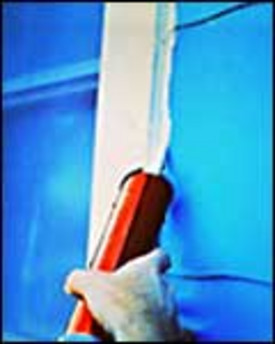Moisture control is also an important aspect of maintaining an energy-efficient home. If humid air leaks into cool spaces, moisture can condense on the cool surfaces and cause damage. In addition, moist insulation has a lower R-value than dry insulation, so moisture problems will lower your home’s energy efficiency.
One aspect of moisture control is to seal air leaks around electrical outlets, switches, and penetrations through the building envelope for plumbing, wiring, ventilating, heating and cooling, and attic access. For instance, a hot water pipe may pass from your unheated basement up into your kitchen. Hardware stores sell a variety of grouts and sealants to plug the gaps around pipes such as these, as well as gaskets to install behind electrical outlets and switches.
Vapor barriers (also called vapor retarders) are another form of moisture control. Vapor barriers include polyethylene sheets, low-perm-rated paints, laminated asphalt-covered building paper, vinyl wall coverings, and foil-type wallpapers. Vapor barriers are now routinely installed in walls during construction projects such as home additions. For existing homes, paints or wallpapers may be the only appropriate options.
Vapor barriers are included on batt or blanket insulation. Vapor barriers should always be placed on the "warm-in-winter" side of the insulation. Do not install a vapor barrier over existing insulation. Air infiltration barriers (also called air retarders) are complementary to vapor barriers. Ideally, air infiltration barriers are comprised of one or more air-impermeable components that are sealed at all joints and penetrations to form a continuous airtight membrane around the building.
When located on the "warm-in-winter" side of insulation, air barriers can double as vapor barriers. Polyethylene sheets are one example of a vapor and air barrier. When located on the "cold-in-winter" side of insulation, as is often done in wood stud construction, the air barrier must be vapor-permeable. Typical vapor-permeable air barriers include polyolefin fabric wrap on sheathing, pressed cardboard, and pleated polystyrene with paper facings.
Credit: U.S. Department of Energy




























